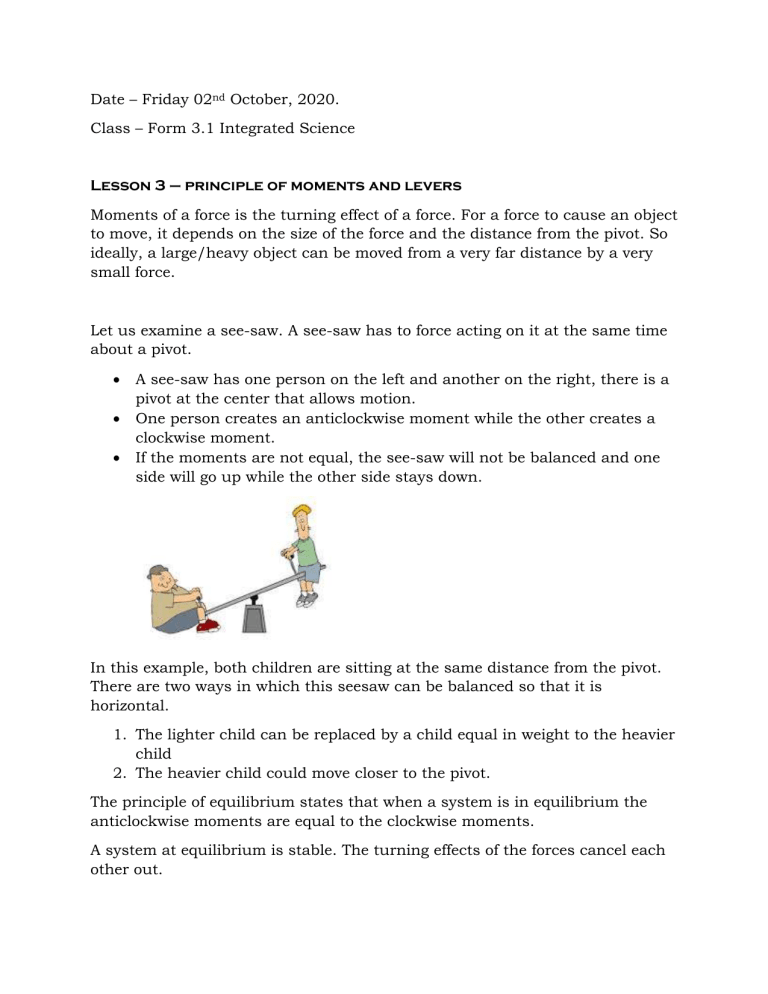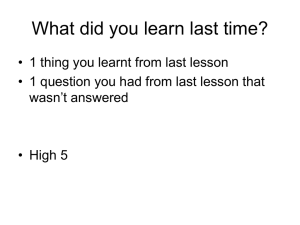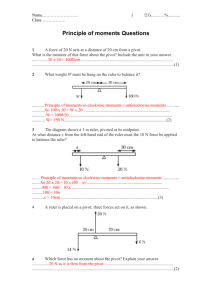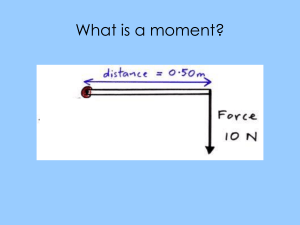
Date – Friday 02nd October, 2020. Class – Form 3.1 Integrated Science Lesson 3 – principle of moments and levers Moments of a force is the turning effect of a force. For a force to cause an object to move, it depends on the size of the force and the distance from the pivot. So ideally, a large/heavy object can be moved from a very far distance by a very small force. Let us examine a see-saw. A see-saw has to force acting on it at the same time about a pivot. A see-saw has one person on the left and another on the right, there is a pivot at the center that allows motion. One person creates an anticlockwise moment while the other creates a clockwise moment. If the moments are not equal, the see-saw will not be balanced and one side will go up while the other side stays down. In this example, both children are sitting at the same distance from the pivot. There are two ways in which this seesaw can be balanced so that it is horizontal. 1. The lighter child can be replaced by a child equal in weight to the heavier child 2. The heavier child could move closer to the pivot. The principle of equilibrium states that when a system is in equilibrium the anticlockwise moments are equal to the clockwise moments. A system at equilibrium is stable. The turning effects of the forces cancel each other out. Examples: 1. This seesaw is balanced: -The clockwise force and anticlockwise forces are the same (50N) -The distance from the pivot is the same (10ft) -The moments are equal on both sides - 50x10=500 -No overall turning effect, so the seesaw is balanced 2. This system is balanced: 30 N -The Force acting clockwise is larger than the anticlockwise force, but the distance from the pivot is shorter. -calculate the clockwise moments = Force (30) X Distance (8m) = 30 X 8 = 240 Nm -calculate the anticlockwise moments = force (20) X distance (12) = 20 X12 = 240 Nm Anticlockwise moments Clockwise moments - The moments are equal on both sides so the system is stable. 3. This system is unbalanced -Both objects are the same distance from the fulcrum (1m) -The Elephant has a much larger force than the rock -Therefore the clockwise moments are much larger than the anticlockwise moments 2 N 200 N Clockwise moments = 200N X 1m = 200 Nm Anticlockwise moments = 2N X 1m = 2 Nm Now you can use the equations of moments of a force and the principle of moments. Practice question: 1. What force F is needed so that the seesaw below is balanced? 1.25m 1.5m F 200 N Solution Clockwise moments = 200N x 1.5m = 300 Nm Anticlockwise moments = F x 1.25m When the seesaw is balanced: Clockwise moments = anticlockwise moments 300 Nm = F x 1.25m F = 300/1.25 F = 240N



